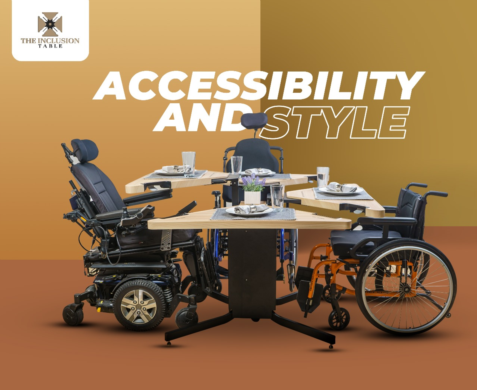
blog address: https://inclusiontable.com/blog/
blog details: Having a wheelchair-accessible dining table or work desk is an important consideration for anyone who uses a wheelchair. It can greatly improve independence and quality of life to be able to simply sit at a table without complication. Whether it’s for dining, working, or other activities, a table that is properly designed for wheelchair users and meets ADA standards can make a big difference in your ability to comfortably and easily use the table. There are some factors worth considering, such as the type of legs or bases, surface height, and materials used. With this, you can find a table that is both functional and comfortable for you or other wheelchair users.
Type Of Legs or Bases
When it comes to the legs or base of a wheelchair-accessible table, there are several options to consider. Some tables have adjustable legs, which can be useful if you need to accommodate for uneven floors or want to be able to change the height of the table. Fixed legs are a more traditional option, but they may not offer as much flexibility.
Casters, or wheels, can also be a good choice if you need to be able to easily move the table around, such as in and out of a dining room or down a hall. When deciding on the right type of table legs or bases for your needs, consider the stability and mobility requirements as well as any specific preferences or constraints you may have.
Surface Height
Table height is an important consideration for wheelchair accessibility. A table that is too high or too low will cause strain on the shoulders and arms, make the table edge more of a risk, and result in difficulty to participate. It’s important to get a table that is the right height for the user to ensure comfort and ease of use.
To determine the right height, measure the height of the user’s wheelchair seat and add a few inches to allow for a comfortable reach to the surface. You may also want to consider the height of any chair that will be used, as chairs should be at a height that able individuals can use. Adjustable tables like our Inclusion Table TM can adjust for multiple chair heights, solving these concerns.
Strength Of the Table
The strength of wheelchair-accessible tables is an important factor to consider. It’s important to make sure that the table has a high enough weight capacity to support any equipment or items that may be placed on the table, especially if this will function as a school desk or library area. Heavy book bags and sometimes the weight of a person leaning against the tables are concerning if the tables aren’t sturdy.
If the tables are adjustable, like The Inclusion Table TM, the table will have to be more sturdy and durable to handle movement without disturbing its surroundings. In the case of The Inclusion Table TM, it has four separate sections for multiple wheelchair users, and the adjustments on one side don’t impact the other three sections.
To determine the right amount of strength needed, consider any additional weight that may be placed on the table. You may also want to consider the user’s weight if anyone will ever be on the table, as well as the material of the table and its overall construction, as these can affect the table’s strength and durability.
Materials
Materials are especially important to consider based on the environment they will be used in. A restaurant table with constant wipe-downs will need different durability than one for a general dining room holding a meal or a desk bracing schoolbooks and studnets. There are several types of materials to consider once you know what you need.
• Wood is a classic choice that can add warmth and character to a space, but it may require more maintenance and may not be as durable as other materials.
• Metal tables can be strong and durable, but they may not be as comfortable to use and can be colder to the touch.
• Plastic tables can be a lightweight and budget-friendly option, but they may not be as durable or aesthetically pleasing as other materials.
When choosing the right material for your table, consider factors such as durability, maintenance requirements, and aesthetics, as well as any specific preferences or needs you may have.
Conclusion
In conclusion, there are several important considerations to keep in mind when choosing a wheelchair-accessible table. These include the type of legs or bases, the table height, the strength of the table, and the materials used. By taking the time to carefully consider these factors, you can find a table that is both functional and comfortable for the user. Don’t be afraid to try out a few different kinds and consult with the user or a healthcare professional to select the right table for your needs.
However, we have tested and tried The Inclusion Table TM and made them the perfect tables for wheelchairs. They aren’t difficult to use, and dining chairs, stools, and any desk chair can fit comfortably to include people of all kinds, wheelchair users or not. It doesn’t exclude any kind of user, and it can bear the weight of backpacks, dinners, and materials of almost any size. Maneuvering and resetting it is easy, and its usefulness can’t be overstated. If there’s anything that will meet your needs for tables as a wheelchair user, it is here.
keywords: Wheelchair accessible dining table
member since: Sep 06, 2024 | Viewed: 64